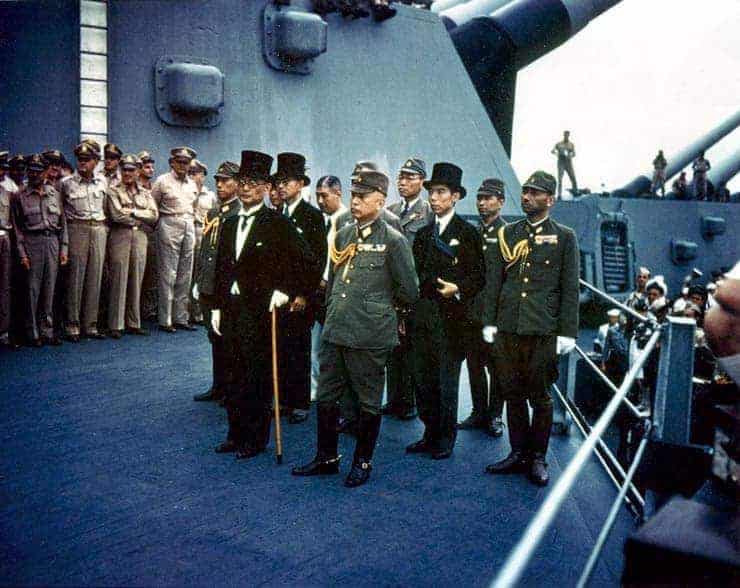On this day in history in 1945, the USS Missouri was the scene for the formal Japanese surrender to the allies. This day was celebrated in America and elsewhere as VJ Day It was the occasion of wild celebrations in many cities. From London to Sydney people celebrated the Japanese surrender with marches and street parties. Those countries that had been occupied by Japan also celebrated VJ day, such as China.
The last Japanese holdouts finally surrendered to the Americans on remote Pacific Islands such as Palau. The representatives of the Emperor and prime minister made preparations to formally offer Japan’s unconditional surrender.
In Tokyo Bay, aboard the Navy battleship USS Missouri, the allies present the Japanese with an ‘instrument of surrender’. This was duly signed by the representatives of the government of Japan. Among the signatories who signed this document are the Japanese foreign minister, Mamoru Shigemitsu and the acting head of the Japanese army, Yoshijiro Umezu. Representing the Allied victors was Gen. Douglas MacArthur, commander of the U.S. Army forces in the Pacific, and Adm. Chester Nimitz, commander of the U.S. Pacific Fleet. Also, present, at the historic event was Lt. Gen. Jonathan Wainwright, who had been freed from a Japanese POW camp in Manchuria, after his capture in the Philippines.

Representatives from all the allied nations are present as the Japanese sign the ‘instruments of surrender’. There are representatives from the United Kingdom, France, The Netherlands, and Canada. Australia and New Zealand also sent representatives to the surrender ceremony on the USS Missouri. They watched the ceremony with great satisfaction as their nations had also suffered losses because of the Japanese aggression. Also present were the Soviets. They did not declare war on Japan until May 1945 after they had seized Berlin. Then they launched an invasion of Manchuria, which they occupied. They also occupied North Korea. The Soviets also seized some islands that are still the source of tension between Moscow and Tokyo to this day.
One of the signatories to the surrender Shigemitsu would be found guilty of war crimes a year later. He was sentenced to seven years in prison for his complicity in Japanese War Crimes. However, he had fought for concessions on the Japanese side in order to secure an early peace and he had wanted to end the war much earlier. Shigemitsu was paroled in 1950 and went on to become chairman of one of Japan’s largest democratic parties. MacArthur would fight him again when he was named commander in chief of the United Nations forces in Korea in 1950.
After the surrender, America occupied Japan and administered it for several years. This period is seen, by historians as vital in the development of Japanese democracy and its subsequent economic growth.


